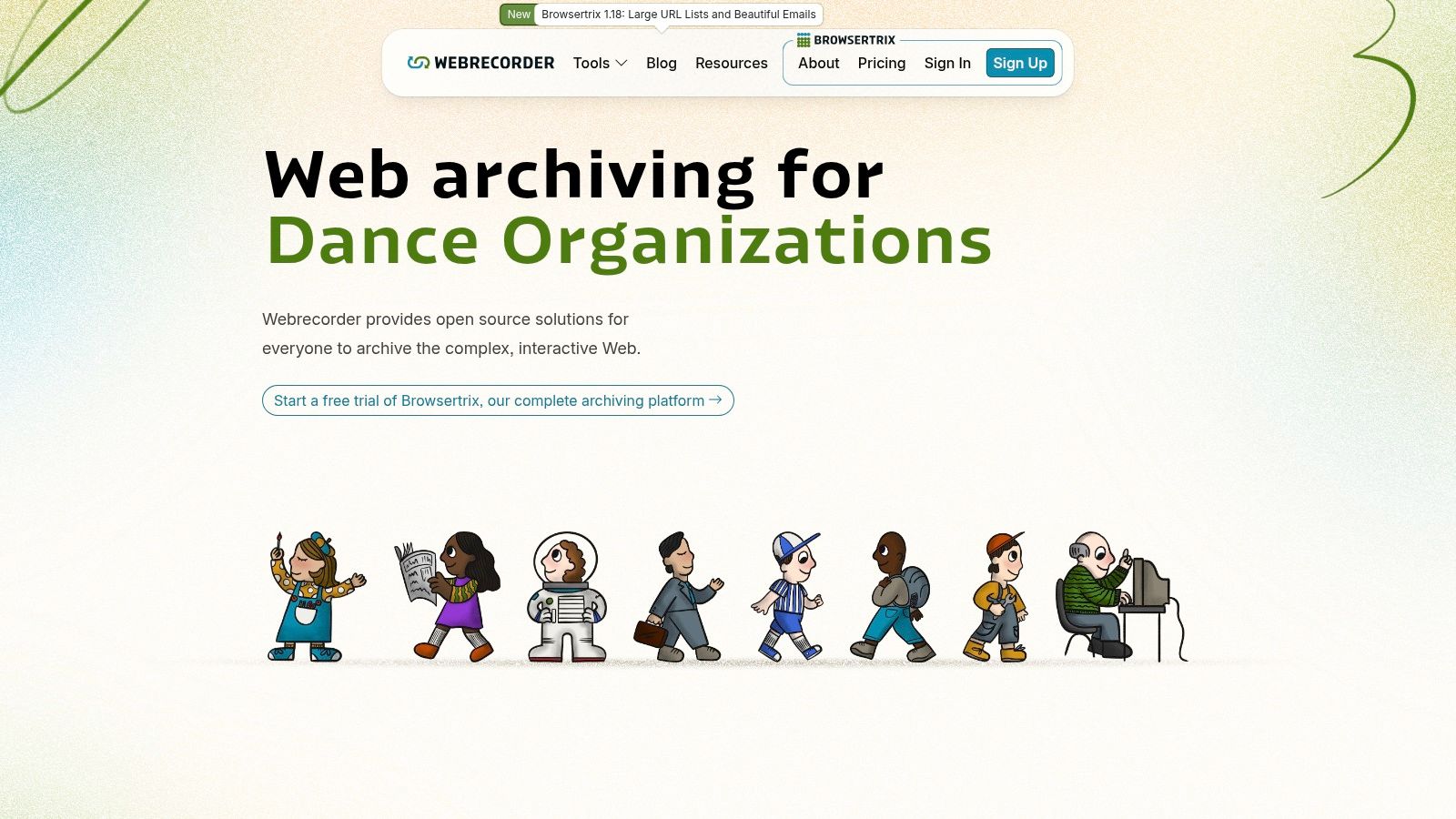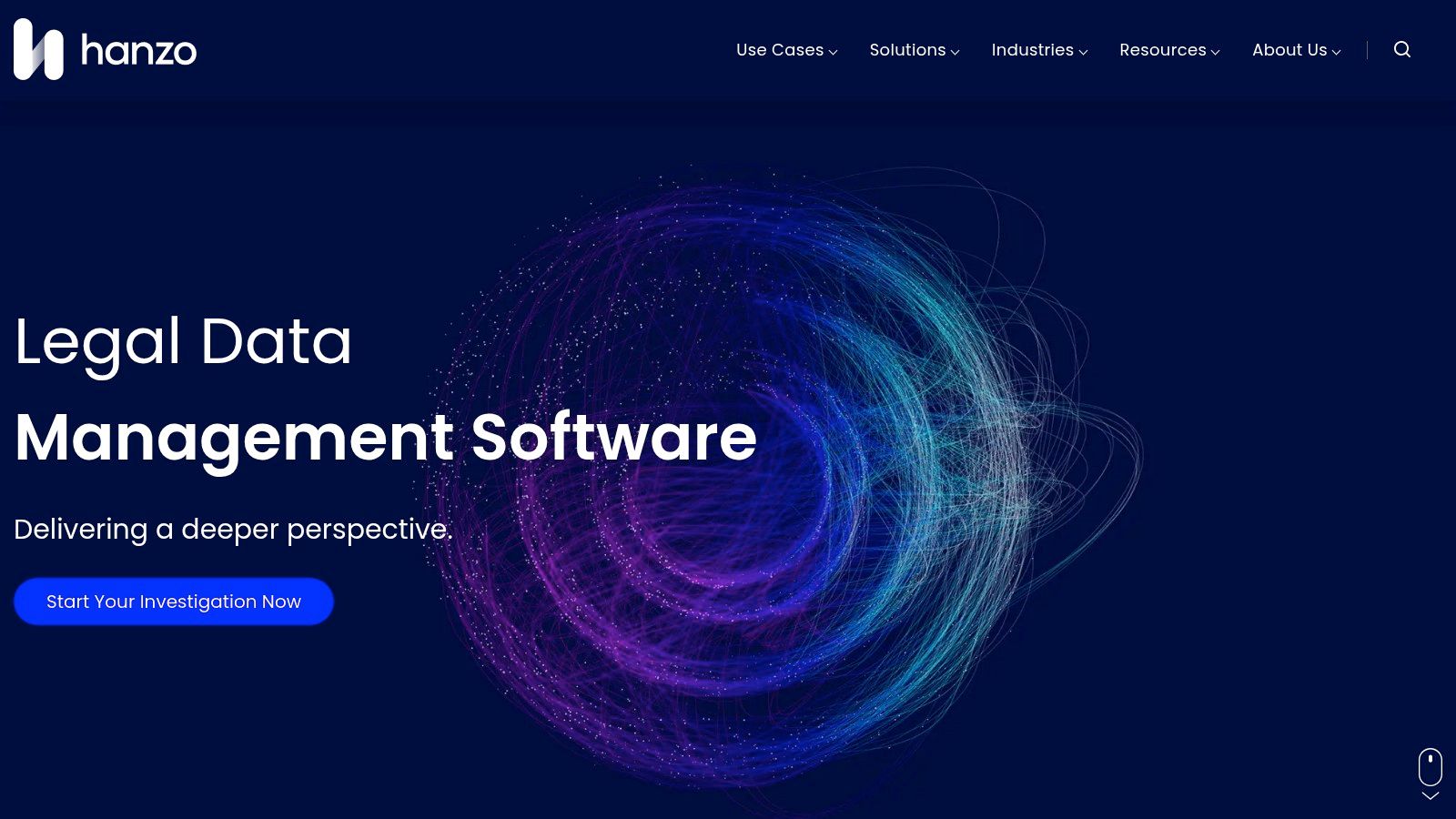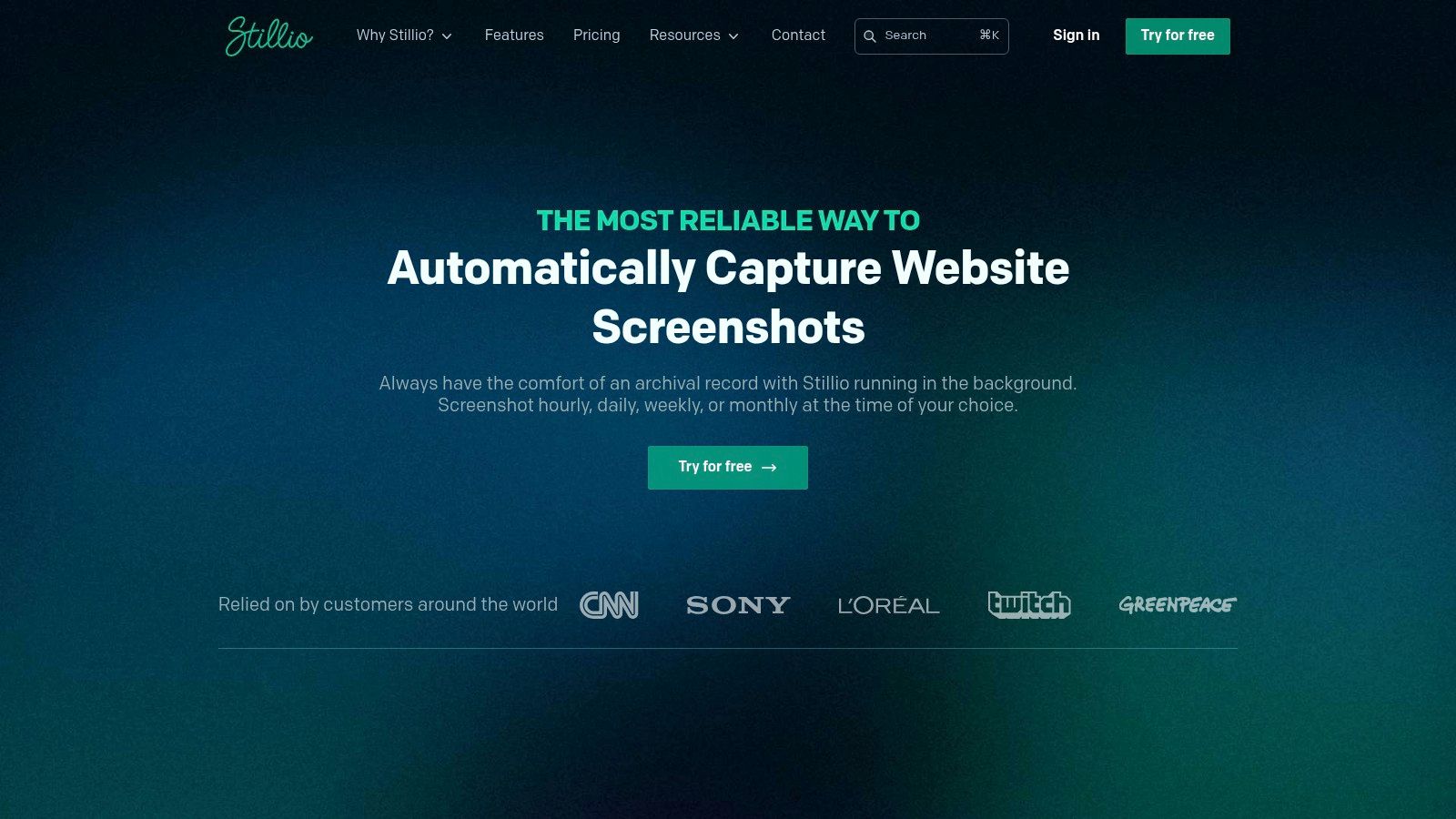Look, we've all screenshotted a page or hit 'Save Page As...' in a pinch. But when you need reliable, verifiable, and scalable web captures, that's just not going to cut it. Link rot is a real problem, content shifts constantly, and JavaScript-heavy sites are a nightmare to preserve accurately. This isn't just about nostalgia; it’s about evidence, research, compliance, and monitoring what's happening online.
This guide cuts through the marketing fluff to give you a straight-up analysis of the 12 best web archiving sites and services out there. We're talking about the heavy hitters like the Internet Archive, niche academic players such as Perma.cc, and the open-source powerhouses like ArchiveBox. For businesses, web archiving is crucial for understanding the market and keeping an eye on rivals; for instance, many find value in leveraging the best competitive tracking tools to monitor competitor activities and gather historical data.
We’ll break down what each platform is actually good for, from legal eDiscovery to simply keeping a personal record of the web. We’ll cover key details like capture fidelity, APIs, pricing models (or lack thereof), and the critical limitations you need to know about before you commit. Each entry includes screenshots and direct links to help you quickly evaluate your options. Let's get into it.
1. Internet Archive – Wayback Machine
The Wayback Machine is the OG of web archiving and usually the first stop for digging up an old version of a webpage. It's the biggest public archive out there, with billions of snapshots spanning decades. This makes it a go-to for researchers, journalists, and anyone just curious about a site's history. Its main gig is giving you on-demand access to past versions of sites through a simple search bar.

Its killer feature is "Save Page Now," which lets anyone capture a live webpage and add it to the public archive, instantly. This makes it a dead-simple option for creating a permanent, public record of a page for citation or evidence. Since it's a non-profit, access is completely free, which sets it apart from the commercial services.
Key Details & Use Cases
- Best For: Quick, on-demand public archiving, historical research, and checking how a site has changed over time.
- Pricing: Completely free.
- Limitations: It's not a real backup solution. Archives often miss dynamic content, JavaScript-heavy elements, and some CSS or images, resulting in broken pages. Fidelity is a huge issue for modern, complex apps. Users have also reported occasional instability following cyberattacks in 2024.
- Practical Tip: Use the browser extension for one-click captures without visiting the main site. If you need a pixel-perfect capture of a complex site, you'll need to supplement the Wayback Machine with a dedicated service. For a deeper dive into digital preservation, check out some info on document archiving software.
Website: https://web.archive.org/
2. Archive-It (by Internet Archive)
If the Wayback Machine is a public utility, Archive-It is its pro-level, subscription-based big brother. Run by the same folks at the Internet Archive, it's built for libraries, archives, universities, and other orgs that need to build and manage their own curated web collections. It gives you the tools for curator-controlled archiving, letting you schedule crawls, define their scope, and add descriptive metadata.
What makes Archive-It stand out is its focus on collection building and long-term preservation. It uses high-fidelity crawling tech (like Brozzler) to better capture dynamic content and provides perpetual WARC storage with backups. Its "Waybackfill" feature is pretty unique—it lets institutions pull relevant older captures from the public Internet Archive into their own collections to fill historical gaps. This focus on institutional control and professional tooling makes it one of the top web archiving sites for formal preservation projects.
Key Details & Use Cases
- Best For: Academic institutions, libraries, government agencies, and organizations needing curated, high-fidelity web collections with pro support and long-term storage.
- Pricing: Quote-based annual subscription, aimed at organizational budgets.
- Limitations: Not for individuals or on-demand, single-page captures. The cost and feature set are built for large-scale, ongoing archival projects, making it overkill for personal use. The UI is designed for professional archivists and has a steeper learning curve than simple capture tools.
- Practical Tip: Before you commit, use the public Wayback Machine to see how well your target sites can be captured. If you're new to web archiving, tap into Archive-It’s training and support to nail down best practices for scoping, QA, and metadata right from the start.
Website: https://archive-it.org/
3. Trove – Australian Web Archive (National Library of Australia)
Trove is the main hub for the Australian Web Archive (AWA) and the go-to resource for anyone researching Australian digital history. Run by the National Library of Australia, it combines selective PANDORA archives with massive domain harvests of the .au top-level domain. This tight focus makes it the definitive source for preserving Aussie online culture and government info, unlike more global web archiving sites.
The platform is plugged into the wider Trove discovery ecosystem, so you can find archived websites alongside books, journals, and newspapers. Its interface gives you clear metadata, collection details, and citation tools for each snapshot. While it doesn't have an on-demand "save page now" feature like the Wayback Machine, its strength is in its systematic, policy-driven collection of nationally significant digital material under Aussie legal deposit laws.
Key Details & Use Cases
- Best For: Academic research, historical analysis of Australian websites, and accessing preserved government web content.
- Pricing: Completely free.
- Limitations: It’s strictly limited to Australian websites. Like many archives, it struggles to perfectly render dynamic, script-heavy, or streaming media content. For legal or commercial reasons, some archived content might be restricted, meaning you'd have to visit the National Library in person.
- Practical Tip: When searching, use the "Websites" filter to narrow your results. If a page doesn't render right, check the different snapshots available for that date, as capture quality can vary between crawls. For high-fidelity captures of modern Aussie sites, you might need to supplement Trove's records with a service like Capture for on-demand archiving.
Website: https://trove.nla.gov.au/
4. Webrecorder – Browsertrix Cloud
Webrecorder is all about high-fidelity, browser-based archiving, which makes it a killer solution for capturing the modern web. Its core tech, Browsertrix, is built to accurately record dynamic, JavaScript-heavy sites that tend to break in traditional crawlers. This focus on fidelity is perfect for preserving complex web apps, social media feeds, and interactive content with a level of accuracy that other web archiving sites just can't match.

The platform comes in two flavors: a managed service (Browsertrix Cloud) and a suite of open-source tools like ArchiveWeb.page and ReplayWeb.page for manual captures and local playback. This flexibility works for everyone from individual researchers needing precise captures to large institutions that require scalable, automated crawling. Its serverless playback system ensures that archived content (WARCs) renders accurately in any modern browser.
Key Details & Use Cases
- Best For: Archiving complex, interactive sites where high fidelity is a must, preserving digital art, and creating accurate records of web apps for legal or academic use.
- Pricing: A free tier is available with limited storage. Paid plans start from US$20/month, with higher-tier and enterprise plans based on annual quotes.
- Limitations: The free and lower-tier plans have tight monthly storage and browser-hour quotas, which you can burn through fast when crawling large or complex sites. The cool advanced features and large-scale crawling are locked behind pricier enterprise plans.
- Practical Tip: Use the free ArchiveWeb.page browser extension for one-off, high-fidelity captures of single pages or user journeys. For bigger projects, plan your crawl scope carefully to stay within your plan’s limits. Focus on essential interactive paths instead of entire domains to get the most out of your resources.
Website: https://webrecorder.net/
5. Perma.cc
Developed by the Harvard Law School Library Innovation Lab, Perma.cc is a niche web archiving service built to fight link rot in academic and legal citations. Its whole point is creating permanent, reliable links ("Perma Links") that guarantee a cited webpage stays accessible forever, even if the original page gets moved or deleted. This focus on citation integrity has made it a standard tool for courts, law reviews, scholars, and journalists.
Unlike broad crawlers, Perma.cc is an on-demand tool. You submit a specific URL to create a durable record, which then gets hosted with a new, permanent URL. Being backed by a major academic institution gives it a strong guarantee of longevity and authority, making it a trusted choice when you need evidentiary-quality archives. The service operates on a registrar model, where affiliated libraries and institutions can offer free, unlimited use to their members.
Key Details & Use Cases
- Best For: Creating permanent, citable links for academic, legal, and journalistic sources; preventing link rot in formal publications.
- Pricing: Free for individuals with a limited number of links per month. Paid plans and link bundles are available for higher volume needs. Affiliated institutional users often get unlimited access.
- Limitations: It’s designed for single-page captures, not for archiving entire sites. The free tier has a strict link quota, so it's not great for large-scale or automated projects without a paid or institutional plan.
- Practical Tip: Integrate Perma.cc into your research workflow early to preserve every source you cite from the get-go. For workflows that need programmatic captures, you could use an HTML to PDF API to supplement Perma.cc by generating high-fidelity PDF snapshots of web evidence.
Website: https://perma.cc/
6. archive.today (aka archive.ph)
archive.today is a straight-to-the-point, on-demand archiving tool that's popular for creating quick, permanent records of individual webpages. Its core function is to capture two versions of a page: a functional HTML snapshot and a high-fidelity PNG screenshot. This dual-capture approach ensures that both the page’s content and its exact visual appearance are preserved, making it super reliable for gathering evidence or citing sources that might vanish.
The service is all about simplicity. You can archive a page without an account just by submitting a URL. It often manages to capture pages behind "soft" paywalls or cookie banners, and its multiple domain mirrors (like archive.ph and archive.is) help if one is blocked. This makes it a go-to choice among web archiving sites for users needing a fast, no-fuss snapshot.
Key Details & Use Cases
- Best For: Creating irrefutable, time-stamped visual and HTML evidence of a single webpage, sharing verifiable links, and archiving ephemeral content.
- Pricing: Completely free.
- Limitations: The service can be flaky, with users sometimes hitting ISP or regional blocks. It's not built for bulk archiving or continuous monitoring, and there’s no public API, which limits its use in automated workflows. The site has also copped some criticism about its ownership and archiving policies.
- Practical Tip: If you can't access the main domain, try one of its mirrors like archive.ph or archive.li. The screenshot feature is especially useful for capturing complex, JavaScript-heavy sites where an HTML-only archive might not render correctly.
Website: https://archive.today/
7. Pagefreezer
Pagefreezer is an enterprise-grade web archiving solution built for organizations with strict compliance, eDiscovery, and records retention rules. Unlike public archives, it provides a comprehensive, legally defensible record of an organization’s entire online presence—websites, social media, team collaboration platforms, and even mobile text messages. It's laser-focused on serving regulated sectors like finance, government, and healthcare.

The platform's strength is its high-fidelity captures, which are stored in WORM (Write Once, Read Many) format to ensure they're tamper-proof and admissible as evidence. Features like digital signatures, timestamps, and full-text search make it a powerhouse for litigation support and regulatory audits. Its FedRAMP authorization also makes it a trusted choice for U.S. government agencies, cementing its spot among the most secure web archiving sites.
Key Details & Use Cases
- Best For: Enterprise-level compliance, legal evidence collection, government record-keeping, and eDiscovery for regulated industries.
- Pricing: Quote-based. This is a premium, enterprise service, so pricing is tailored to your org's needs.
- Limitations: Not a tool for casual or individual use. The platform is designed for large-scale, automated corporate archiving, making it way too complex and expensive for personal projects or simple on-demand captures.
- Practical Tip: When checking out Pagefreezer, focus on its legal and compliance features. Ask about its evidence collection services and legal hold capabilities—these are its key differentiators. The ability to export in multiple formats (WARC, PDF) and provide authenticated records is crucial for legal workflows.
Website: https://www.pagefreezer.com/
8. MirrorWeb
MirrorWeb is an enterprise-grade, cloud-native archiving platform built for organizations that need serious compliance and data sovereignty. It’s a powerful tool used by government bodies and heavily regulated industries like finance to capture and preserve their entire digital presence, including websites, social media, and internal comms. The platform specializes in creating legally admissible, tamper-proof archives for compliance with standards like SEC, FINRA, and FCA.

Its core strength is capturing complex, dynamic web content with high fidelity, including JavaScript-heavy single-page apps and personalized user experiences. All data is stored in ISO-compliant WARC format on WORM (Write Once, Read Many) storage to ensure authenticity. With features like full-text search across all archived content and an "Archive Compare" tool to visualize changes, it provides a comprehensive portal for managing huge digital records.
Key Details & Use Cases
- Best For: Governments, financial services, and other regulated organizations needing comprehensive, compliant web and social media archiving with high-fidelity capture.
- Pricing: Quote-based annual contracts. Its enterprise focus means it's not for individual users or small projects.
- Limitations: This is a premium, enterprise-level service with a price tag to match. The platform is built for large-scale, ongoing archiving, not one-off public captures, making it inaccessible for casual or small-scale use.
- Practical Tip: When evaluating MirrorWeb, ask about their data sovereignty options. They can store your archive in specific geographic locations (e.g., UK, USA, EU), which is a critical requirement for many orgs dealing with data privacy regs like GDPR.
Website: https://www.mirrorweb.com/
9. Hanzo
Hanzo is an enterprise-grade platform designed for corporate legal and compliance teams who need defensible, high-fidelity web archiving. It goes beyond simple page captures to provide a full eDiscovery solution for complex, dynamic websites and modern collaboration platforms. Its strength lies in creating legally sound archives for litigation, regulatory investigations, and internal audits, where authenticity and chain of custody are everything.

The platform is built for evidentiary quality, capturing web content in the standard WARC format and storing it on WORM (Write Once, Read Many) storage with cryptographic hashes and detailed audit logs. This ensures the data is tamper-proof and admissible in court. Hanzo's automated crawlers can map and capture intricate websites, while its Illuminate product extends this to platforms like Slack and Google Workspace, making it a complete solution for corporate data preservation.
Key Details & Use Cases
- Best For: Corporate legal teams, compliance officers, and regulated industries needing defensible archives for eDiscovery and litigation support.
- Pricing: Enterprise-level pricing available upon request via a demo or quote. Not suitable for individuals or small businesses.
- Limitations: This is a specialized, high-cost solution aimed squarely at the enterprise market. Its focus on legal workflows makes it too complex and expensive for general-purpose web archiving or historical research.
- Practical Tip: Talk to Hanzo when your primary reason for web archiving is legal risk or regulatory compliance. Its SOC 2 Type II compliance and robust audit trails are key selling points for proving due diligence to auditors and lawyers.
Website: https://hanzo.co/
10. Stillio
Stillio carves out a specific niche in web archiving by focusing exclusively on automated, scheduled screenshots. Instead of creating complex, interactive WARC files, it offers a simple, reliable service for capturing visual evidence of websites over time. This makes it perfect for compliance, brand monitoring, and tracking competitor activity without the technical overhead.

The platform’s strength is its "set it and forget it" automation. You can configure captures for multiple URLs at intervals as frequent as every five minutes. This makes it a priceless tool for organizations that need to keep a consistent visual record for regulatory proof, tracking ad placements, or monitoring SEO changes. The simplicity means you get clean, timestamped images without the complexity of full-fidelity archiving.
Key Details & Use Cases
- Best For: Automated visual compliance records, brand and competitor monitoring, and tracking website changes over time with image-based evidence.
- Pricing: Tiered subscription plans based on the number of URLs and capture frequency, starting from US$29/month.
- Limitations: This is a screenshot service, not a true web archive. It captures a static image only—no interactive content, underlying code, or WARC files for full replay. The default retention is 36 months, with longer-term storage costing extra, which might not work for permanent archival needs.
- Practical Tip: Use Stillio's Zapier and Dropbox integrations to automatically push your screenshot archives to cloud storage. This creates a redundant backup and makes the visual evidence easily accessible to other teams without everyone needing to log into the Stillio dashboard.
Website: https://www.stillio.com/
11. ArchiveBox (open source, self‑hosted)
For developers and power users who want full ownership of their data, ArchiveBox offers a powerful, self-hosted web archiving pipeline. Instead of relying on a third-party service, this open-source tool lets you create your own comprehensive, private archive. It pulls in URLs from various sources and saves them in multiple durable formats—HTML, PDF, screenshots, media files, and standard WARCs—ensuring your data stays accessible and under your control.

The key differentiator for ArchiveBox is its "no vendor lock-in" philosophy. By storing archives in standard, long-lasting file formats, it guarantees you can access your data with or without the software. This focus on privacy, control, and automation makes it one of the most robust web archiving sites for technical users who'd rather manage their own infrastructure than pay for a managed service.
Key Details & Use Cases
- Best For: Creating a private, self-managed archive, automated ingesting of bookmarks or browser history, and building custom archiving workflows.
- Pricing: Completely free (you're on the hook for hosting and storage costs).
- Limitations: The main drawback is the technical overhead. You have to manage your own hosting, storage, software updates, and system dependencies. The setup and maintenance require command-line skills and aren't for non-technical users.
- Practical Tip: Deploy ArchiveBox using Docker for a more straightforward and isolated setup, which simplifies dependency management. For advanced workflows needing high-fidelity captures, you can integrate it with an external rendering service; a website screenshot API can produce pixel-perfect images and PDFs to supplement your archives.
Website: https://archivebox.io/
12. UK Government Web Archive (The National Archives, UK)
The UK Government Web Archive, managed by The National Archives, is a vital resource for accessing historical UK central government websites and social media content. It’s a model for national-level web archiving sites, providing authoritative, permanent records of official information. The platform offers public access to archived content through timeline snapshot links, A-Z browsing, and full-text search, ensuring transparency and preserving digital government history.

Its commitment to open standards is a key feature; the archive is Memento compliant, which lets users find archived versions of a government URL from any browser with a Memento extension. Crawls are handled by a third-party service (MirrorWeb) to ensure robust and consistent captures. This specialization makes it an indispensable tool for researchers, journalists, and legal pros who need access to official UK government information that's no longer live.
Key Details & Use Cases
- Best For: Researchers, historians, and legal professionals needing authoritative access to historical UK government websites and policy documents.
- Pricing: Completely free.
- Limitations: The scope is highly specialized and limited to UK central government content, not the wider web. While generally reliable, user access has faced temporary disruptions related to wider technical incidents affecting The National Archives.
- Practical Tip: Use the timeline view for a specific URL to see all available snapshots, identified by a permanent YYYYMMDDHHMMSS link. This is ideal for citing a specific version of a government page at a precise point in time. The full-text search is powerful for finding specific policy documents or press releases across all archived domains.
Website: https://www.nationalarchives.gov.uk/webarchive/
Top 12 Web Archiving Sites Comparison
| Service | Core features ✨ | Quality ★ | Unique strengths 🏆 | Target audience 👥 | Pricing 💰 |
|---|---|---|---|---|---|
| Internet Archive – Wayback Machine | Snapshot calendar, Save Page Now, Memento playback | ★★★★ | Free, largest public archive, broad historical coverage | 👥 Researchers, journalists, public | 💰 Free |
| Archive‑It (Internet Archive) | Scheduled crawls, Brozzler, WARC storage, QA/metadata | ★★★★ | Curator tools, perpetual WARC, IA integration | 👥 Libraries, archives, institutions | 💰 Quote-based annual |
| Trove – Australian Web Archive | .au domain harvests, multi-snapshot timeline, citations | ★★★★ | AU legal‑deposit scope, Trove discovery integration | 👥 Australian researchers, libraries | 💰 Free |
| Webrecorder – Browsertrix Cloud | Browser-based crawling/replay, WARC, QA tooling | ★★★★★ | High fidelity for JS-heavy sites, SaaS or self-host | 👥 Archivists, devs capturing modern web apps | 💰 Tiered (free → paid) |
| Perma.cc | Create Perma Links, stable URLs, managed library model | ★★★★ | Library-backed, citation-friendly (Bluebook) | 👥 Courts, law reviews, journalists, scholars | 💰 Freemium / paid for volume |
| archive.today (archive.ph) | Immediate HTML snapshot + visual screenshot, mirrors | ★★★ | Fast, no‑account public URLs, captures ephemeral content | 👥 Casual users, journalists, quick evidence capture | 💰 Free |
| Pagefreezer | High-fidelity capture, eDiscovery, WORM export (WARC/PDF) | ★★★★★ | Compliance focus (FedRAMP), legal/evidence services | 👥 Regulated agencies, enterprises, legal teams | 💰 Quote-based enterprise |
| MirrorWeb | Dynamic JS capture, full-text search, ISO WARC/WORM | ★★★★★ | Data‑sovereignty, compliance (SEC/FINRA/FCA) | 👥 Governments, regulated firms, large archives | 💰 Quote/annual |
| Hanzo | WARC on WORM, hashes/audit logs, automated crawling, AI | ★★★★★ | Defensible eDiscovery, AI triage, SOC 2 | 👥 Legal teams, enterprises, eDiscovery pros | 💰 Enterprise pricing (quote) |
| Stillio | Scheduled screenshots, visual diffs, retention options | ★★★★ | Fast setup, visual monitoring, simple tiers | 👥 Brands, marketers, evidence/logging | 💰 Tiered subscription (self-serve) |
| ArchiveBox (open source) | Self‑hosted pipeline, HTML/PDF/PNG/TXT/WARC outputs, CLI/API | ★★★★ | No vendor lock-in, private control, flexible exports | 👥 Power users, orgs, devs wanting control | 💰 Free open‑source (hosting costs apply) |
| UK Government Web Archive | Timeline snapshots, permanent links, full-text search | ★★★★ | Authoritative UK government coverage, Memento compliant | 👥 Researchers, public, policy analysts | 💰 Free |
Choosing Your Tool: WARCs, Screenshots, or APIs?
We’ve covered a lot of ground here, from public giants and enterprise platforms to self-hosted tools. It can feel like a lot, but the main takeaway is this: the "best" tool depends entirely on what you're trying to do. There's no single silver bullet for preserving the web.
Your first step should be figuring out your goal. Are you a researcher needing historical context? A lawyer who needs defensible evidence? Or a dev trying to capture a dynamic, app-like website? Each use case points to a different type of tool.
Matching the Tool to the Task
Let's break down the key decision points from the web archiving sites we've looked at:
- For General-Purpose & Historical Lookups: You can't beat the Internet Archive's Wayback Machine. For broad, public-facing archiving, it's the gold standard. Researchers and the general public will find its massive collection indispensable.
- For Legal, Compliance & eDiscovery: Your focus has to be on defensibility. Enterprise solutions like Pagefreezer, MirrorWeb, and Hanzo are built for this. They provide legally admissible archives with clear chains of custody, metadata, and digital signatures—all non-negotiable in regulated industries.
- For High-Fidelity & Dynamic Content: When you're dealing with JavaScript-heavy SPAs or complex user interactions, standard crawlers often fail. Webrecorder's Browsertrix Cloud is the champ here, using browser-based tech to capture sites exactly as they look and feel.
- For Absolute Control & Customisation: If you have the tech chops and need full ownership of your data, a self-hosted solution is the way to go. ArchiveBox gives you a powerful, open-source framework you can deploy and tweak to your exact needs, giving you ultimate control over your archives.
- For Long-Term Academic & Institutional Preservation: Services like Perma.cc and Archive-It are made for academic libraries, legal journals, and cultural heritage organizations. They focus on link longevity and institutional-level collection management.
The Future of Archiving: APIs, Automation, and Web3
Beyond these platforms, there's a clear shift toward programmatic and automated solutions. You don't always need a full-blown archiving system. Sometimes, you just need a pixel-perfect snapshot, a high-quality PDF, or a scheduled visual record of a webpage piped directly into your workflow. That's where rendering APIs come in. They offer a more lightweight, flexible option for tasks like visual regression testing, automated reporting, or generating marketing assets.
As the web becomes more decentralized, the challenges of data preservation are changing, too. The rise of Web3 brings new complexities around storing on-chain data and decentralized app states. New platforms are popping up to tackle this. For instance, Kyve, a Web3 data lake solution, is designed specifically for scalable and permanent data preservation in a decentralized ecosystem. This points to a critical trend: archiving tech has to keep evolving with the web's underlying architecture.
Ultimately, picking your tool is about matching capability to need and cost to value. Whether you're preserving national history with Trove, ensuring corporate compliance, or just capturing a single page with perfect fidelity, the right tool is out there. Start with your end goal, consider your technical constraints, and don't be afraid to mix and match tools to create a hybrid solution that works for you.
When your project demands high-fidelity, on-demand captures without the overhead of a full archiving suite, Capture is the developer-friendly API you need. Integrate programmatic screenshots and PDF generation directly into your application for automated reporting, visual monitoring, or content creation. Explore the API and start building for free at Capture.

